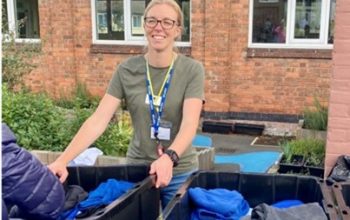Toolkit for a school uniform swap
June 20, 2025

We’ve put together a toolkit to help guide you through setting up a school uniform swap, from the planning, through to delivery.
What is a school uniform swap?
A school uniform swap encourages families to donate school uniforms that are outgrown or no longer required, but still in wearable condition. The uniforms, sportswear and bags are then made available so that other families can make use of them for free or at minimal cost.
School uniforms can be very expensive, especially in recent times when the cost of living has increased. Some elements of the uniform may be branded or need to be purchased from a particular supplier, and so there isn’t always a low-cost option. Children grow so quickly and often uniforms can be outgrown and still be in excellent condition having had very little wear.
A report in 2020 (the Wrong Blazer report by The Children’s Society) showed that 1.4 million wearable school uniforms are thrown away in the UK every year. It found that children in state-maintained schools spent on average £337 per year on school uniform for each secondary school child and £315 per year for each primary school child.
Nearly a quarter of parents surveyed (23%) said that the cost of school uniform had meant their child had worn ill-fitting, unclean or incorrect uniform.
Current Guidance
In November 2021 the UK Government published statutory guidance for state-funded schools in England on school uniform costs. These came into force in September 2022.
The intention was to make school uniforms more affordable by keeping branded items to a minimum, and for parents to have the option of purchasing second-hand uniforms. Information on the school’s uniform policy should be available for parents to see on the school’s website, along with clear information on second-hand uniforms. Parents and pupils should have the opportunity to engage with the school when the school uniform policy is being developed.
Saving money and resources
Organising school uniform swaps, and reusing uniforms, can really help families save money, but they also stop uniforms going to waste unnecessarily. There is a huge environmental impact in producing the clothing to begin with and so keeping these uniforms (or any clothing) in use for longer, really helps to reduce this.
A school uniform swap can be a one-off event, in a similar way to an ordinary clothes swap, but it’s usually part of a range of activities or events, organised by parents or guardians in collaboration with the school and community. Local organisations, businesses and retailers might be interested in supporting the event or be happy to be involved.
It can be very rewarding to see these uniforms rehomed, especially with the sense of community and collaboration involved and the financial rewards for those that use the service.
1. How to get started
Plan
The first thing is to decide what you are hoping to achieve and put together a plan. Is the goal to reduce waste, help families save money, or both. Do you want to start small and keep it manageable, focusing on one specific school and its uniform? Or did you want to cover a wider area with multiple schools and uniforms.
It’s worth checking if a school uniform swap already exists in your area and whether there is any benefit in joining forces. Are there any parts of the uniform that overlap with other nearby schools. There are a few uniform swaps already running in Leicestershire and it might be worth seeing how they run theirs:
North West Leicestershire School uniform Swap shops and list of venues participating
Hinckley & Bosworth BC – school uniform swaps
Leicester Children’s Holidays – Leicester City School uniform project
Recruit others to help
See who else might be able to help. Speak to the school and see if you can raise it at their PTA (Parents and Teachers Association) meetings. As well as parents, teachers and school staff, there may be community members, local businesses and community organisations or venues that might like to be involved. There’ll be plenty to organise and once you know how you would like it to run, you’ll be able to make a list of tasks and assign roles.
2. How’s it going to work? – things to consider:
Cost
Is the intention for the school uniforms to be donated and rehomed to families at no cost? Is that manageable? Consider if any local businesses, organisations or retailers might be interested in sponsoring the project or event. If the aim is to reduce waste and keep uniforms in use for longer then perhaps making them available at a small cost could still be an effective option.
How often will it run?
Is the swap going to be a one-off event or part of an ongoing project? If it’s part of an ongoing project you might be able to set up a regular time to run the swap shop, perhaps a set day and time in the week, or a monthly event. A regular time can often help with publicity, as people will become familiar with when it is. However, it’s worth bearing in mind that school uniforms are often required for the start of the autumn term and so holding the swap shops during the summer could be really useful. You might need to find a community venue for this as the school might not be available.
Donations – drop off, storage and display
It’s worth considering what condition you would like the uniforms to be in and perhaps make this clear. Could you offer a repair service for very simple repairs? If so, can this be carried out between the drop off and the event? What will you do with any unusable donations? Are you going to ask for uniform donations to be dropped off in advance? If so, consider the locations and timings of where items can be dropped off – ideally, you want it to be somewhere convenient and accessible to as many people as possible. Perhaps the school has somewhere suitable? If not consider local community venues or retailers close by.
What will you collect the uniforms in? A large plastic container or basket could work. Remember to label it clearly and state the items you want to be dropped off. What will you do with any donations that aren’t the correct uniform? Do you have contacts for other uniform swaps so that you can pass them on to another scheme nearby?
Where will you store any donated uniforms before the event? Will the donations need to be collected from the drop-off site periodically and stored somewhere else? Will the storage be secure, and can it be accessed out of hours if required?
You’ll need to consider how you will display the uniforms at the event? Will you use clothes rails or lay them out neatly on tables? Will the uniforms need washing and ironing beforehand so that they look their best?
Publicity
How will you let people know about the project and event? Can the school publicise it on their website? Does the school have a WhatsApp group or Facebook page that you can use? Can you put posters up in the school and the local community, such as library, community centre, notice board or local retailer. You could even write a short article or see if you can get a mention in a local newsletter and remember that word of mouth is still one of the most effective methods of publicity.
Sort and prepare
The uniforms might need a bit of care before the event, washing, ironing and folding neatly so that they can be displayed looking their best. You might want to group them in readiness for when they’re displayed.
3. At the event and after
Will you have a changing room or somewhere to enable the uniforms to be checked for size, or can they be returned if the fit isn’t correct?
Will you have a mirror available?
Whether you have clothes rails or tables, it’s a good idea to produce labels to categorise the uniforms into item and size, to make it easier for people to locate the uniform they need.
Keep a record
It’s a good idea to keep a record of the donations and how many of the uniforms get rehomed. This information can be useful to help track the impact of the project. Do ask for feedback from families that use the service because testimonials can be helpful and shared in any publicity. Remember to take photos, too, but consider the need for permissions.
Evaluation
It’s worth getting everyone together afterwards to discuss how it all went, not just the event itself, but all the planning and preparations too. It provides an opportunity to think about what aspects went well and how you could amend it slightly going forwards. It’s very likely that it will be an evolving process until you find a way that works for all and not necessarily perfect straight away. It can be hard work and time consuming, but incredibly rewarding when it works well.










